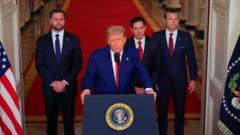Is Trump's Praise for US Strikes on Iran's Nuclear Facilities Justified?

# The Escalating Conflict: Analyzing Recent Military Actions in Iran
The recent military strikes on Iranian nuclear facilities have sparked a significant global conversation about international relations, military strategy, and the future of peace in the Middle East. President Donald Trump characterized these actions as a "spectacular military success," urging Iran to pursue peace while simultaneously warning of further military action if negotiations falter. This article delves into the events surrounding this conflict, the implications for regional and global stability, and what this means for future diplomatic efforts.
## The Background of the Conflict
The roots of the current conflict can be traced back to long-standing tensions between the United States and Iran, particularly concerning Iran's nuclear program. The U.S. has been deeply concerned about Iran's potential to develop nuclear weapons, leading to a series of sanctions and diplomatic negotiations aimed at curbing their nuclear ambitions. Despite these efforts, tensions escalated dramatically in June 2023 when Israel launched surprise attacks on Iranian nuclear and military targets.
### Timeline of Key Events
1. **June 13, 2023**: Israel conducts an unexpected military operation targeting Iranian nuclear facilities, marking a significant escalation in hostilities.
2. **June 14-15, 2023**: In retaliation, Iran fires hundreds of rockets and drones at Israel, leading to casualties on both sides.
3. **June 20, 2023**: President Trump announces U.S. military strikes on three major Iranian nuclear sites—Fordo, Natanz, and Esfahan.
4. **June 21, 2023**: In a televised address, Trump declares the strikes a success and warns Iran of further military action if peace is not achieved quickly.
## Military Strategy and Tactical Considerations
The U.S. military's use of "bunker buster bombs," specifically the GBU-57A Massive Ordnance Penetrator, highlights the gravity of the situation. These bombs are designed to penetrate hardened structures, making them effective against fortified facilities such as those used for nuclear enrichment.
### Key Targets
1. **Fordo Facility**: Hidden underground, this facility has been a focal point of international concern due to its capacity for uranium enrichment.
2. **Natanz Facility**: This site has previously been targeted due to its significance in Iran's nuclear program.
3. **Esfahan Facility**: A key location for uranium conversion, its destruction would severely hinder Iran's nuclear capabilities.
The choice of these targets underscores the U.S. military's strategic goal: to cripple Iran's ability to pursue nuclear weapons in a decisive manner.
## The Political Landscape
The military strikes have not only impacted Iran's nuclear program but have also shifted the political dynamics in the Middle East. Trump's statements, delivered alongside high-ranking officials, emphasized a unified front against what he termed Iran's "bullying" in the region.
### Reactions from Key Players
- **Iran**: While the Iranian government has not fully disclosed the extent of the damage, military officials have reported significant retaliation against Israel, resulting in casualties and heightened tensions.
- **Israel**: Prime Minister Benjamin Netanyahu expressed support for the U.S. action, reiterating the principle of "peace through strength." His comments reflect a long-standing Israeli strategy of preemptive action against perceived threats.
- **International Community**: The strikes have drawn mixed reactions internationally. While some nations may support the U.S. stance on Iranian nuclear capabilities, others view the strikes as an escalation that could lead to broader conflict.
## The Human Cost of Conflict
The ongoing hostilities have resulted in significant human suffering. According to reports from the Human Rights Activists News Agency (HRANA), the death toll has reached 657 individuals, with a substantial number of casualties arising from Iran's retaliatory strikes on Israel. The conflict underscores the dire humanitarian implications of military action in densely populated regions.
### The Impact on Civilians
- **Casualties**: The loss of civilian lives is an unfortunate consequence of military conflicts, and both sides have experienced tragic losses.
- **Displacement**: As violence escalates, families are forced to flee their homes, leading to a humanitarian crisis.
- **Psychological Effects**: The ongoing conflict can have lasting effects on the mental health of civilians, including anxiety, depression, and post-traumatic stress disorder (PTSD).
## The Path Forward: Peace or Further Conflict?
President Trump’s address emphasized the need for Iran to pursue negotiations to avoid further military action. However, the reality on the ground suggests a complex and challenging path to peace.
### Diplomacy in the Face of Aggression
While military strikes may achieve short-term objectives, long-term peace requires diplomatic engagement. The U.S. has indicated a willingness to reach out to Iran "diplomatically," suggesting that future negotiations could play a crucial role in de-escalating tensions.
### Challenges to Negotiation
- **Trust Deficit**: Both nations harbor deep-seated mistrust, complicating any efforts toward meaningful dialogue.
- **Regional Alliances**: The involvement of other nations in the conflict, including Israel and various Arab states, adds layers of complexity to the negotiation process.
- **Public Opinion**: Domestic pressures within Iran and the U.S. could influence the willingness of both governments to engage in diplomacy.
## Conclusion: A Critical Juncture for Peace
The recent military actions in Iran represent a pivotal moment not only for U.S.-Iran relations but for the broader Middle East. As President Trump has articulated, the choice lies between peace and tragedy. The coming days and weeks will be critical in determining the direction of this conflict.
As the world watches, it is essential to consider the consequences of military action and the urgent need for diplomatic solutions. The stakes are high, and the potential for greater tragedy looms if peace is not prioritized.
### What Lies Ahead?
As tensions continue to rise, the question remains: Will the U.S. and Iran find a path to peace, or will the cycle of violence persist? Only time will tell, but the need for careful consideration and strategic dialogue has never been more vital.
#### FAQs
What were the main targets of the U.S. military strikes in Iran?
The main targets were the Fordo, Natanz, and Esfahan nuclear facilities, which are critical to Iran's nuclear enrichment capabilities.How has Iran responded to the U.S. military strikes?
Iran has launched retaliatory attacks against Israel, resulting in casualties and escalating tensions in the region.What are the potential consequences of continued military action in the Middle East?
Continued military action could lead to further civilian casualties, displacement, and a broader humanitarian crisis, as well as increased instability in the region. ### Engage with the Discussion As we reflect on these events, the need for peace and diplomacy becomes increasingly evident. How do you believe the international community should respond to the escalating tensions in Iran? #MiddleEast #IranConflict #PeaceThroughStrengthPublished: 2025-06-22 02:43:05 | Category: wales



